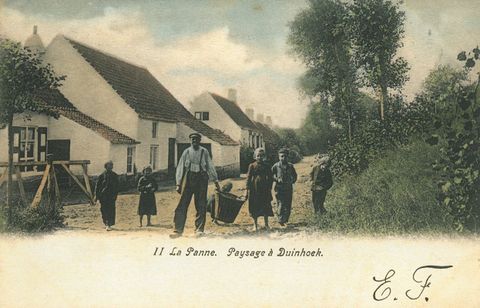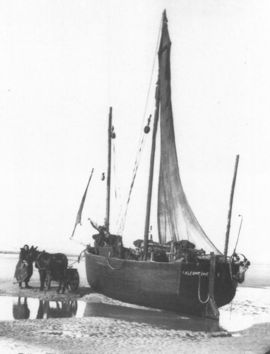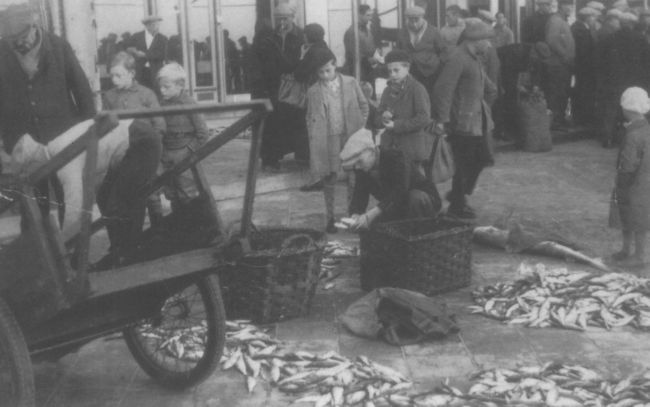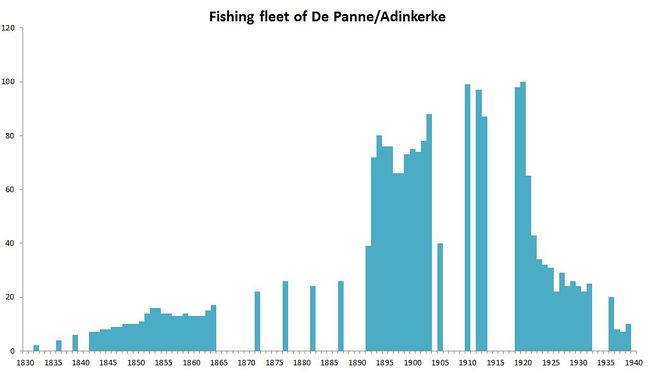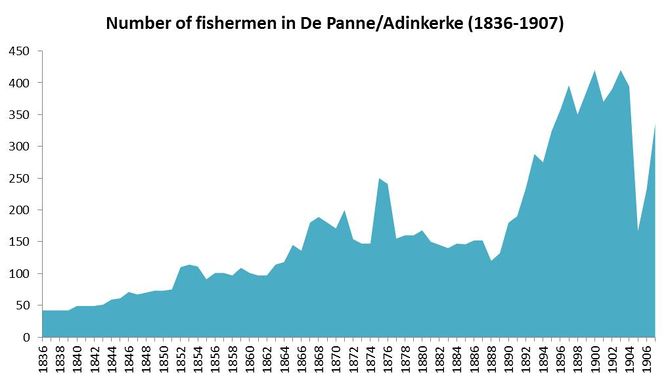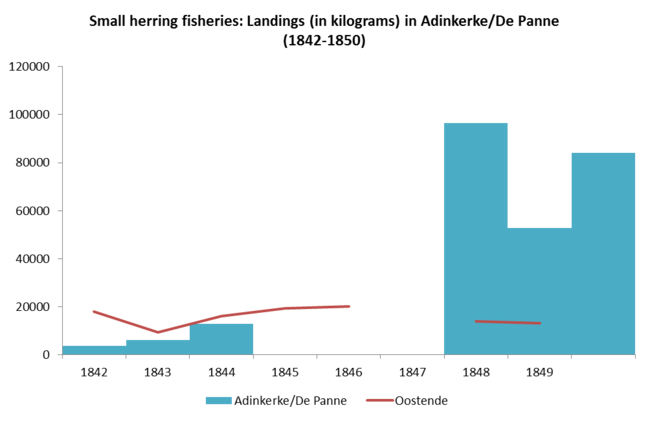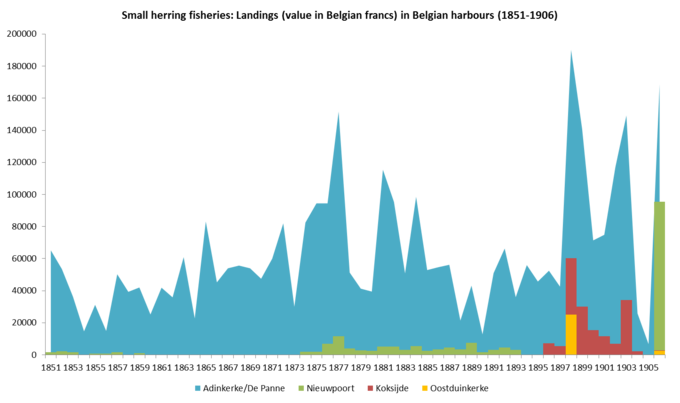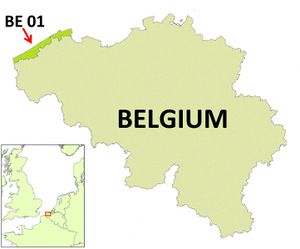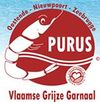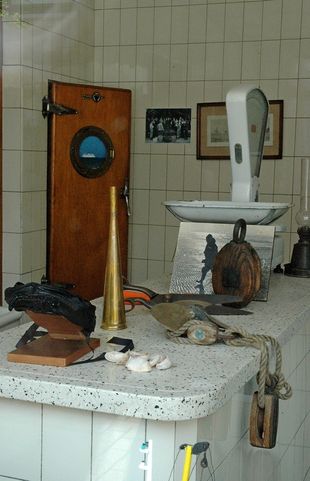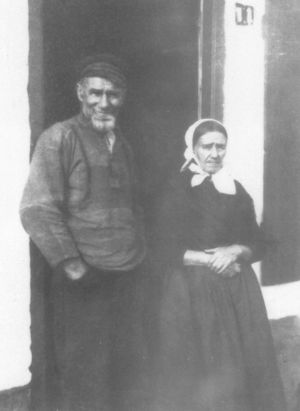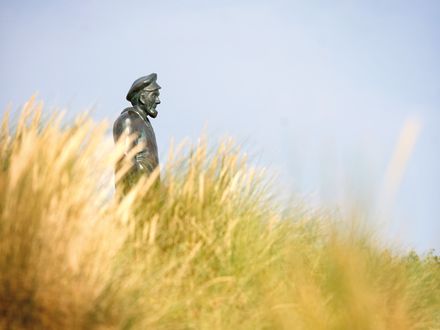Difference between revisions of "Fisheries in De Panne"
(→Quality labels) |
(→Branding) |
||
| (26 intermediate revisions by 2 users not shown) | |||
| Line 4: | Line 4: | ||
The Belgian coast is 67 km long and is entirely bordering the province of West-Flanders (region of Flanders, Belgium). The Belgian part of the North Sea is 3,457 km<sup>2</sup> (0.5% of the North Sea area), of which more than 1/3 or 1,430 km² are territorial sea within 12 nautical miles distance of the coastline. Belgium currently has 10 coastal municipalities and 4 coastal ports (Nieuwpoort, Oostende, Zeebrugge and Blankenberge), and besides the fish auctions located in Oostende, Zeebrugge and Nieuwpoort where fish is sold according to legal procedures, there are no other dispersed landing points. Although historically the port and auction of Oostende was by far the most important, today the auctions of Zeebrugge (53%) and Oostende (45%) receive the largest share of the landings of Belgian fisheries in Belgian ports. | The Belgian coast is 67 km long and is entirely bordering the province of West-Flanders (region of Flanders, Belgium). The Belgian part of the North Sea is 3,457 km<sup>2</sup> (0.5% of the North Sea area), of which more than 1/3 or 1,430 km² are territorial sea within 12 nautical miles distance of the coastline. Belgium currently has 10 coastal municipalities and 4 coastal ports (Nieuwpoort, Oostende, Zeebrugge and Blankenberge), and besides the fish auctions located in Oostende, Zeebrugge and Nieuwpoort where fish is sold according to legal procedures, there are no other dispersed landing points. Although historically the port and auction of Oostende was by far the most important, today the auctions of Zeebrugge (53%) and Oostende (45%) receive the largest share of the landings of Belgian fisheries in Belgian ports. | ||
| − | Belgium has a minor role in the European fisheries context with 0.35% of the total EU production of fish. In 2012, the Belgian commercial sea fishing fleet counted 86 ships, with a total engine capacity of 49,135 kW and gross tonnage of 15,326 GT <ref name="Roegiers"> [http://www.vliz.be/en/imis?module=ref&refid=224957 Roegiers, B.; Platteau, J.; Van Bogaert, T.; Van Gijseghem, D.; Bekaert, K.; De Bruyne, S.; Delbare, D.; Depestele, J.; Lescrauwaet, A.-K.; Moreau, K.; Polet, H.; Robbens, J.; Vandamme, S.; Van Hoey, G.; Verschueren, B. (2013). VIRA Visserijrapport 2012 Departement Landbouw en Visserij: Brussel. 98 pp.] </ref>. 45 vessels are part of the Small Fleet Segment (max 221 kW engine power) of which 2 use passive gear. The remaining 41 vessels belong to the Large Fleet Segment and have an engine power between 221 kW and a maximum of 1,200 kW. This fleet segment represents approximately 80% of the engine power capacity and 77% of the | + | Belgium has a minor role in the European fisheries context with 0.35% of the total EU production of fish. In 2012, the Belgian commercial sea fishing fleet counted 86 ships, with a total engine capacity of 49,135 kW and gross tonnage of 15,326 Gross Tonnage (GT)<ref name="Roegiers"> [http://www.vliz.be/en/imis?module=ref&refid=224957 Roegiers, B.; Platteau, J.; Van Bogaert, T.; Van Gijseghem, D.; Bekaert, K.; De Bruyne, S.; Delbare, D.; Depestele, J.; Lescrauwaet, A.-K.; Moreau, K.; Polet, H.; Robbens, J.; Vandamme, S.; Van Hoey, G.; Verschueren, B. (2013). VIRA Visserijrapport 2012 Departement Landbouw en Visserij: Brussel. 98 pp.] </ref>. 45 vessels are part of the Small Fleet Segment (max 221 kW engine power) of which 2 use passive gear. The remaining 41 vessels belong to the Large Fleet Segment and have an engine power between 221 kW and a maximum of 1,200 kW. This fleet segment represents approximately 80% of the engine power capacity and 77% of the Gross Tonnage of the fleet. While a smaller number use trammel nets (passive gear) and otter trawl, the largest share of the Large Fleet Segment are beam trawl vessels (≥662 kW). The Belgian fleet is highly specialized: more than 68% of the effort(days at sea) and 77% of total landings are achieved by beam trawlers(2010)focusing primarily on flatfish species such as plaice (<i>Pleuronectes platessa</i>) and sole (<i>Solea solea</i>). The results of the reconstruction of the Belgian fleet dynamics since 1830 are presented in Lescrauwaet et al. 2013<ref name="LescrauwaetPhD">[http://www.vliz.be/en/imis?module=ref&refid=228661 Lescrauwaet, A.-K. (2013). Belgian fisheries: ten decades, seven seas, forty species: Historical time-series to reconstruct landings, catches, fleet and fishing areas from 1900. PhD Thesis. Ghent University (UGent): Gent. xiii, 242 pp.] </ref>. |
The number of days at sea per vessel is fixed at a maximum of 265 per year and in 2011 the entire fleet realized a fishing effort of 15,855 days at sea. In 2011, the Belgian fleet landed a total of 20,138t, of which 16,905t were landed in Belgian ports. Plaice is the most important species in terms of landed weight. The landings of 2011 represented a value of €76.3 million, 14% of which was marketed in foreign ports. Sole generates 47% of the current total value of fisheries in Belgium. The Belgian sea fisheries represent 0.04% of the national Gross Domestic Product <ref> [http://www.vliz.be/en/imis?module=ref&refid=131093 Anon. (2008). Strategische Milieubeoordeling van het Nationaal Operationeel Plan voor de Belgische visserijsector, 2007 - 2013. ILVO Visserij: Oostende. 103 pp.]</ref>. The main fishing grounds in terms of volume of landings in 2010 were in descending order: North Sea South (IVc), Eastern English Channel (VIId), North Sea Central (IVb), Southeast Ireland/Celtic Sea (VIIg) Bristol Channel (VIIf) and Irish Sea (VIIa). | The number of days at sea per vessel is fixed at a maximum of 265 per year and in 2011 the entire fleet realized a fishing effort of 15,855 days at sea. In 2011, the Belgian fleet landed a total of 20,138t, of which 16,905t were landed in Belgian ports. Plaice is the most important species in terms of landed weight. The landings of 2011 represented a value of €76.3 million, 14% of which was marketed in foreign ports. Sole generates 47% of the current total value of fisheries in Belgium. The Belgian sea fisheries represent 0.04% of the national Gross Domestic Product <ref> [http://www.vliz.be/en/imis?module=ref&refid=131093 Anon. (2008). Strategische Milieubeoordeling van het Nationaal Operationeel Plan voor de Belgische visserijsector, 2007 - 2013. ILVO Visserij: Oostende. 103 pp.]</ref>. The main fishing grounds in terms of volume of landings in 2010 were in descending order: North Sea South (IVc), Eastern English Channel (VIId), North Sea Central (IVb), Southeast Ireland/Celtic Sea (VIIg) Bristol Channel (VIIf) and Irish Sea (VIIa). | ||
| Line 17: | Line 17: | ||
| − | De Panne (Geographical coordinates: 51°06'N 2°36'E) is the westernmost Belgian coastal town, which means it shares a border with France. It has a population of almost 10.800 people. The history of De Panne is closely linked with that of Adinkerke, nowadays a small village, situated about 3 kilometres from the sea, that belongs to the municipality of De Panne. The situation used to be reversed however: during the late 18th century, De Panne was part of the larger parish and municipality of Adinkerke <ref name="Gys">[http://www.vliz.be/en/imis?module=ref&refid=225642 Gyselinck, N.; Lanszweert, W.; Steevens, I.; Wolny, M. (2013). Kust- en zeevisserij, in: Steevens, I. et al. (Ed.) (2013). Zeevisserij aan de Vlaamse kust. pp. 114-165.]</ref>. Yet, because of the growing importance of coastal tourism from the late 19th century on, De Panne eventually transformed into a larger town than Adinkerke and became independent in 1911 <ref name="geschiedenis">[http://www.depanne.be/product/467/geschiedenis-van-de-panne-en-adinkerke-in-een-notendop Geschiedenis van De Panne en Adinkerke in een notendop], Site Gemeente De Panne.</ref>. Originally though, De Panne was | + | De Panne (Geographical coordinates: 51°06'N 2°36'E) is the westernmost Belgian coastal town, which means it shares a border with France. It has a population of almost 10.800 people. The history of De Panne is closely linked with that of Adinkerke, nowadays a small village, situated about 3 kilometres from the sea, that belongs to the municipality of De Panne. The situation used to be reversed however: during the late 18th century, De Panne was part of the larger parish and municipality of Adinkerke <ref name="Gys">[http://www.vliz.be/en/imis?module=ref&refid=225642 Gyselinck, N.; Lanszweert, W.; Steevens, I.; Wolny, M. (2013). Kust- en zeevisserij, in: Steevens, I. et al. (Ed.) (2013). Zeevisserij aan de Vlaamse kust. pp. 114-165.]</ref>. Yet, because of the growing importance of coastal tourism from the late 19th century on, De Panne eventually transformed into a larger town than Adinkerke and became independent in 1911 <ref name="geschiedenis">[http://www.depanne.be/product/467/geschiedenis-van-de-panne-en-adinkerke-in-een-notendop Geschiedenis van De Panne en Adinkerke in een notendop], Site Gemeente De Panne.</ref>. Originally though, De Panne was primarily a fishing place. It was only founded in 1783, during the time the Austrian branch of the Habsburg Monarchy ruled the Southern Netherlands. Emperor Joseph II wanted to stimulate the inshore fisheries and therefore agreed with the proposition of six dignitaries from Veurne to erect a small fishing settlement in the dunes between Adinkerke and Koksijde. Two years after its foundation, the village of De Panne (originally named ‘Josephdorp’ - after Joseph II - and ‘Kerckepanne’) already counted 26 houses <ref name="Gys"/><ref>[http://www.vliz.be/en/imis?module=ref&refid=221639 Bauwens, J. (2012). Ooit droomden Pannese vissers van een 'eigen' haventje!, in: Berquin, H. (Ed.) (2012). In het zand geschreven. De duinen van de Westhoek: een geschiedenis. pp. 193-229.]</ref><ref name="Devent">[http://www.vliz.be/en/imis?module=ref&refid=196194 Devent, G. (1989). De Vlaamse zeevisserij. Marc Van de Wiele: Brugge. ISBN 90-6966-061-X. 208 pp.]</ref>. The fishers used specific vessels, called ''‘pannepotten’'' or ''‘panneschuiten’'', which moored on the beach <ref>[http://www.vliz.be/en/imis?module=ref&refid=9606 Desnerck, G.; Desnerck, R. (1976). Vlaamse visserij en vissersvaartuigen: 2. De vaartuigen. Gaston Desnerck: Oostduinkerke. 543 pp.]</ref>. |
{|style="margin:10px auto" | {|style="margin:10px auto" | ||
| Line 26: | Line 26: | ||
|} | |} | ||
| − | The fisheries - and especially the small herring fisheries close to the coast - in De Panne flourished from the middle of the 19th century on, and the fishing community steadily grew <ref name="Gys"/>. Around the turn of the century, a number of shipyards were active in De Panne, while several small fish smoke houses were also present in the village <ref name="Desnerck">[http://www.vliz.be/en/imis?module=ref&refid=9601 Desnerck, G.; Desnerck, R. (1974). Vlaamse visserij en vissersvaartuigen: 1. De havens. Gaston Desnerck: Oostduinkerke. 256 pp.]</ref>. An important figure in this thriving evolution was [http://www.vliz.be/en/imis?module=ref&show=search Pierre Bortier] (1805-1879), a wealthy landowner and philanthropist, who strongly believed that agriculture and fisheries were the crucial basis for a prosperous society. Bortier was closely involved in the fishery life of De Panne and encouraged the fishermen to take ownership of their very own fishing vessels, which was one of the reasons for the prosperous situation of the fisheries sector in De Panne during the second half of the 19th century <ref name="Desnerck"/><ref name="geschiedenis"/>. With 2050 inhabitants and 88 fishing vessels in 1903, De Panne was the second most important Belgian fishers community (after Ostend) at the time <ref name="Gys"/><ref name="Zuttere">[http://www.vliz.be/nl/imis?module=ref&refid=36108 De Zuttere, C. (1909). Enquête sur la pêche maritime en Belgique: introduction, recencement de la pêche maritime. Lebègue & cie: Bruxelles. 634 pp]</ref>. The lack of | + | The fisheries - and especially the small herring fisheries close to the coast - in De Panne flourished from the middle of the 19th century on, and the fishing community steadily grew <ref name="Gys"/>. Around the turn of the century, a number of shipyards were active in De Panne, while several small fish smoke houses were also present in the village <ref name="Desnerck">[http://www.vliz.be/en/imis?module=ref&refid=9601 Desnerck, G.; Desnerck, R. (1974). Vlaamse visserij en vissersvaartuigen: 1. De havens. Gaston Desnerck: Oostduinkerke. 256 pp.]</ref>. An important figure in this thriving evolution was [http://www.vliz.be/en/imis?module=ref&show=search Pierre Bortier] (1805-1879), a wealthy landowner and philanthropist, who strongly believed that agriculture and fisheries were the crucial basis for a prosperous society. Bortier was closely involved in the fishery life of De Panne and encouraged the fishermen to take ownership of their very own fishing vessels, which was one of the reasons for the prosperous situation of the fisheries sector in De Panne during the second half of the 19th century <ref name="Desnerck"/><ref name="geschiedenis"/>. With 2050 inhabitants and 88 fishing vessels in 1903, De Panne was the second most important Belgian fishers community (after Ostend) at the time <ref name="Gys"/><ref name="Zuttere">[http://www.vliz.be/nl/imis?module=ref&refid=36108 De Zuttere, C. (1909). Enquête sur la pêche maritime en Belgique: introduction, recencement de la pêche maritime. Lebègue & cie: Bruxelles. 634 pp]</ref>. The lack of its harbour however, eventually led to the decline of the fishery industry in De Panne. Although over the years, several plans were made for the construction of a harbour for the fishing fleet of De Panne, none of these projects actually succeeded. After the First World War, more and more fishers left De Panne for Nieuwpoort and Ostend and soon after the Second World War, all professional fishery activity in De Panne ceased to exist <ref name="Gys"/>. |
[[Image:Fig._3._vismijn.jpg|center|650px]] | [[Image:Fig._3._vismijn.jpg|center|650px]] | ||
| Line 39: | Line 39: | ||
:Graph 1: Fishing fleet in De Panne/Adinkerke ((Source: '''1832-1841''': [http://www.vliz.be/en/imis?module=ref&refid=77961 (1866). Rapport de la Commission chargée de faire une enquête sur la situation de la pêche maritime en Belgique. Séance du 17 mai 1866. Chambre des Représentants: Bruxelles. XLII, 75 pp.]; '''1842-1864''': Enquete sur la situation de la peche maritime en belgique instituee par arrete du 20 avril 1865, '''1872-1903''': [http://www.vliz.be/nl/imis?module=ref&refid=42954 ICES Fisheries Statistics = Bulletin Statistique des Pêches Maritimes], '''1905''': [http://www.vliz.be/nl/imis?module=ref&refid=36108 De Zuttere (1909). Enquête sur la pêche maritime en Belgique], '''1910''': [http://www.vliz.be/nl/catalogus?module=ref&refid=127278 Von Schoen, F. (1912). La pêche maritime de la Belgique], '''1928''': [http://www.vliz.be/nl/open-marien-archief?module=ref&refid=200137 Officieele lijst der visschersvaartuigen]). | :Graph 1: Fishing fleet in De Panne/Adinkerke ((Source: '''1832-1841''': [http://www.vliz.be/en/imis?module=ref&refid=77961 (1866). Rapport de la Commission chargée de faire une enquête sur la situation de la pêche maritime en Belgique. Séance du 17 mai 1866. Chambre des Représentants: Bruxelles. XLII, 75 pp.]; '''1842-1864''': Enquete sur la situation de la peche maritime en belgique instituee par arrete du 20 avril 1865, '''1872-1903''': [http://www.vliz.be/nl/imis?module=ref&refid=42954 ICES Fisheries Statistics = Bulletin Statistique des Pêches Maritimes], '''1905''': [http://www.vliz.be/nl/imis?module=ref&refid=36108 De Zuttere (1909). Enquête sur la pêche maritime en Belgique], '''1910''': [http://www.vliz.be/nl/catalogus?module=ref&refid=127278 Von Schoen, F. (1912). La pêche maritime de la Belgique], '''1928''': [http://www.vliz.be/nl/open-marien-archief?module=ref&refid=200137 Officieele lijst der visschersvaartuigen]). | ||
| − | + | Due to the prosperous situation of the fisheries sector in De Panne and Adinkerke during the second half of the 19th century, lots of people were employed in this industry. Graph 2 illustrates the number of fishermen from 1936 until 1907. The number especially peaked around the turn of the century, parallel to the development of the fishing fleet of De Panne and Adinkerke. In 1900, no less than 420 fishermen were active in De Panne and Adinkerke <ref name="Zuttere"/>. | |
[[Image:Graph_2_De_Panne.jpg|center|670px]] | [[Image:Graph_2_De_Panne.jpg|center|670px]] | ||
| Line 57: | Line 57: | ||
[[Image:Graph_5_Belgie_De_Panne.png|center|690px]] | [[Image:Graph_5_Belgie_De_Panne.png|center|690px]] | ||
| − | + | :::Graph 5: Landings (value in Belgian francs) of fresh fish in Adinkerke/De Panne (red line) (1836-1907) (Source: [http://www.vliz.be/nl/open-marien-archief?module=ref&refid=36108 Dezuttere, 1909]). | |
| − | ===<span style="color:#3a75c4; Font-size: 130%">'''<small> | + | ===<span style="color:#3a75c4; Font-size: 130%">'''<small>Governance and Organisations</small>'''</span>=== |
---- | ---- | ||
| − | + | In Belgium, the '''FLAG''', also called the ‘local group’, ‘Plaatselijke Groep Belgisch Zeevisserijgebied’, is a partnership between socio-economic stakeholders in the fisheries sector, NGOs and public authorities that play a crucial role in the implementation of the proposed development strategy. The lead partner of the Belgian FLAG is the Province of West Flanders. The main focus of the FLAG strategy is to add value to local fisheries products and increase local consumption. Belgian landings represent only 10% of fisheries products consumed in Belgium, leaving the remaining 90% to be met by imports. Therefore there is a considerable potential for discovering and developing local markets. It will also support diversification, innovation, the involvement of women and efforts to promote the sustainable management of the marine environment<ref>[https://webgate.ec.europa.eu/fpfis/cms/farnet/flagsheet/flag-factsheet-belgium-west-flanders FLAG factsheet - Belgium - West Flanders]</ref>. | |
| + | |||
| + | [[Image:FLAG.jpg|center|300px|]] | ||
| + | ::::::::::Fig. 6. [https://webgate.ec.europa.eu/fpfis/cms/farnet/belgian-flag-factsheet Belgian FLAG area: West Flanders] | ||
| − | [ | + | In De Panne, the '''local history and heritage club ‘[https://sites.google.com/site/debliedemaker/geschiedenis-1/de-heemkundige-vereniging--panneboot-p1 De Panneboot P1]’''' was founded in 1993. Its primary objective is the preservation, maintenance and promotion of the maritime heritage that laid the foundation for the development of this coastal town. The most important activity of this club is the maintenance of the fishing vessel ‘De Pannevisser P1’, but its members also collect all kinds of data about the history of fisheries in De Panne and the West Coast <ref>[https://sites.google.com/site/debliedemaker/geschiedenis-1/de-heemkundige-vereniging--panneboot-p1 Heemkundige vereniging ‘De Panneboot P1’], Site De Bliedemaker.</ref>. More recently, this organisation was also the driving force behind the foundation of the ‘[http://www.depanne.be/product/717/retrohuis-de-viswinkel Retrohuis De Viswinkel]’ (''‘Retrohouse The Fish Shop’'') <ref name="viswinkel">[http://www.depanne.be/product/717/retrohuis-de-viswinkel Retrohuis De Viswinkel], Site Gemeente De Panne.</ref> (see also ‘Fisheries related activities’). |
===<span style="color:#3a75c4; Font-size: 130%">'''<small>Branding</small>'''</span>=== | ===<span style="color:#3a75c4; Font-size: 130%">'''<small>Branding</small>'''</span>=== | ||
---- | ---- | ||
| − | [[Image:Purus.jpg|100px|thumb|left]] | + | [[Image:Purus.jpg|100px|thumb|left|link=]] |
The Flemish brown shrimp is a typical fisheries product in Belgium. In 2006 the '''Purus label''' was introduced by a cooperation of ship owners, the cooperative Flemish fisheries organization (Cooperative Vlaamse Visserij Vereniging CVBA) to promote the Flemish unpeeled brown shrimps. The brown shrimps are caught by Belgian fishermen, the fishermen fish no longer than 24 hours and the shrimps are cooked in old Flemish manner (in sea water with salt), there are no additives, preservatives added. This all results in high quality taste. The Purus label also promotes sustainable fishing techniques. | The Flemish brown shrimp is a typical fisheries product in Belgium. In 2006 the '''Purus label''' was introduced by a cooperation of ship owners, the cooperative Flemish fisheries organization (Cooperative Vlaamse Visserij Vereniging CVBA) to promote the Flemish unpeeled brown shrimps. The brown shrimps are caught by Belgian fishermen, the fishermen fish no longer than 24 hours and the shrimps are cooked in old Flemish manner (in sea water with salt), there are no additives, preservatives added. This all results in high quality taste. The Purus label also promotes sustainable fishing techniques. | ||
| − | |||
| − | |||
| − | ===<span style="color:#3a75c4; Font-size: 130%">'''<small> | + | [[Image:North_Sea_Life.jpg|100px|thumb|left|link=]] |
| + | Since 2011, the Flemish Shellfish- and fish cooperation (VSVC) supply, via an exclusive quality label, '''North Sea Life''', life brown shrimps and swimming crabs to restaurants and wholesalers. Life shrimps allows chefs to determine how they will prepare the shrimps. Life product forms the base of creative and gastronomic possibilities. The same is true for life swimming crabs. In 2013 a minimum of 200 kilo life brown shrimps were landed each day. Prices for life shrimps are on average 30 percent higher than shrimps cooked on board of the shrimp vessel<ref>[http://www.ilvo.vlaanderen.be/NL/Persenmedia/Allemedia/tabid/6294/articleType/ArticleView/articleId/1105/language/nl-NL/ILVO-ziet-in-rauwe-garnaal-meer-dan-lucratieve-niche.aspx#.UyBv6vldVSL ILVO ziet in rauwe garnaal meer dan lucratieve niche]</ref>. | ||
| + | <br style="clear:both"/> | ||
| + | |||
| + | ===<span style="color:#3a75c4; Font-size: 130%">'''<small>Fish as Food</small>'''</span>=== | ||
---- | ---- | ||
| − | + | De Panne has several '''fish shops''', of which an overview can be found [http://www.goudengids.be/viswinkels/de-panne-8660/ here] and [https://www.google.be/maps/search/depanne+viswinkel/@51.096890,2.590292,13z here]. | |
| − | |||
| − | |||
| − | |||
| + | [http://www.hotelfox.org/intro.html ‘Hostellerie Le Fox’], a '''restaurant''' with two Michelin stars, is located near the sea wall of De Panne. The chef, Stéphane Buyens, is a passionate advocate of using local ingredients in his dishes. For his fish meals, he resolutely chooses fresh fish from the North Sea. This includes such species as plaice, cod, sole and shrimp, which he deems ‘the caviar of the North Sea’ <ref>[http://www.hetlekkerewesten.be/stephane-buyens.html Interview Stéphane Buyens, Site Het Lekkere Westen.]</ref>. Several other restaurants in the neighbourhood, such as [http://www.leflore.be/nl/2011/04/la-cuisine/ ‘Le Flore’], [http://www.tram57.be/?page_id=13 ‘Tram 57’], [http://www.la-coupole.be/NL/fiche.asp?itemnr=16445 ‘La Coupole’] and [http://www.aufiletdesole.be/LaPanne/index.php?option=com_wrapper&view=wrapper&Itemid=12 ‘Au Filet de Sole’], also value working with local products and fresh North Sea fish. | ||
| − | + | ===<span style="color:#3a75c4; Font-size: 130%">'''<small>Tourism/Education</small>'''</span>=== | |
| − | |||
| − | |||
| − | |||
| − | ===<span style="color:#3a75c4; Font-size: 130%">'''<small> | ||
---- | ---- | ||
| Line 106: | Line 105: | ||
|} | |} | ||
| − | *The '''statue''' of local fisherman Pier Kloeffe can be found in the dunes of De Panne. Pier Kloeffe (1853-1939) was born in 1853 as Petrus Decreton. However, his whole family was given the nickname Kloeffe, because their ancestors ran an inn called ‘De Kloeffe’ on the road to Veurne. Pier Kloeffe made nine fishing trips to Iceland, but decided after the First World War to stay closer to home. From then on, Pier appeared every day without fail on the beach of De Panne, ready to practise 'gill net fishing’. He was always dressed in the typical fishing attire of the region, which consisted of a blue sailor’s hat with a black brim, a red linen shirt (''‘kazuifel’'' in Dutch) and thick dark blue trousers. His white beard was typical | + | *The '''statue''' of local fisherman Pier Kloeffe can be found in the dunes of De Panne. Pier Kloeffe (1853-1939) was born in 1853 as Petrus Decreton. However, his whole family was given the nickname Kloeffe, because their ancestors ran an inn called ‘De Kloeffe’ on the road to Veurne. Pier Kloeffe made nine fishing trips to Iceland, but decided after the First World War to stay closer to home. From then on, Pier appeared every day without fail on the beach of De Panne, ready to practise 'gill net fishing’. He was always dressed in the typical fishing attire of the region, which consisted of a blue sailor’s hat with a black brim, a red linen shirt (''‘kazuifel’'' in Dutch) and thick dark blue trousers. His white beard was typical of the old Iceland fishermen <ref>[http://tourism.depanne.be/product/1203/pier-kloeffe Pier Kloeffe], Site Gemeente De Panne.</ref>. The statue on the beach of De Panne is an enlargement of a 30-centimetre tall figurine made earlier by the artist Louis Van den Eynde (1881-1966), who was a close friend of Pier Kloeffe <ref>[http://www.dekust.be/ontdekken/beeld-pier-kloeffe Beeld Pier Kloeffe], Site De Kust.</ref>. |
{|style="margin:10px auto" | {|style="margin:10px auto" | ||
| Line 121: | Line 120: | ||
[[Image:Fig._9._visjchersmesse.jpg|center|600px|]] | [[Image:Fig._9._visjchersmesse.jpg|center|600px|]] | ||
:::::Fig. 9. People in traditional gear during the Fisheries Mass in De Panne (© [http://www.flickr.com/photos/flandrien/9070253884/in/set-72157634177447241/ Alfred Penel, 2013]). | :::::Fig. 9. People in traditional gear during the Fisheries Mass in De Panne (© [http://www.flickr.com/photos/flandrien/9070253884/in/set-72157634177447241/ Alfred Penel, 2013]). | ||
| + | |||
| + | In 1894, a first attempt was made to open a '''fisheries school''' in De Panne, but it was unfortunately a short-lived endeavor. However, in 1903, the reverend father Vanneste resurrected the idea and founded a fisheries school, modelled after similar institutes in other Belgian coastal towns. The fisheries school in De Panne was one of the most attended, with around 80 or 90 students <ref> [http://www.vliz.be/en/imis?module=ref&refid=225640 Beun, A.-S.; Lanszweert, W.; Leerman, F.; Steevens, I. (2013). Kinderen in de visserij en het onderwijsaanbod, in: Steevens, I. et al. (Ed.) (2013). Zeevisserij aan de Vlaamse kust. pp. 68-91.]</ref>. The school closed its doors in 1935 <ref>[http://visserijschooljohnbauwens.be/pagina9aaaaaaaaaaaaaaaaa.html Voorgeschiedenis], Site Visserijschool John Bauwens.</ref>. | ||
| + | |||
| + | ===<span style="color:#3a75c4; Font-size: 130%">'''<small>Summary</small>'''</span>=== | ||
| + | |||
| + | {{Gifs -- Harbor template | ||
| + | |locationauctions=The fish auction was originally held in the Veurnestraat in De Panne, but relocated to the seawall after the First World War. | ||
| + | |FLAG=West Flanders | ||
| + | |brandlabels=The Purus label promotes the Flemish unpeeled brown shrimps.<br /> | ||
| + | Via ‘North Sea Life’ label, the Flemish Shellfish- and fish cooperation (VSVC) supply life brown shrimps and swimming crabs to restaurants and wholesalers. | ||
| + | |restaurantshotels=[http://www.hotelfox.org/intro.html ‘Hostellerie Le Fox’], a '''restaurant''' with two Michelin stars.<br /> | ||
| + | Several other restaurants in the neighbourhood, such as [http://www.leflore.be/nl/2011/04/la-cuisine/ ‘Le Flore’], [http://www.tram57.be/?page_id=13 ‘Tram 57’], [http://www.la-coupole.be/NL/fiche.asp?itemnr=16445 ‘La Coupole’] and [http://www.aufiletdesole.be/LaPanne/index.php?option=com_wrapper&view=wrapper&Itemid=12 ‘Au Filet de Sole’], also value working with local products and fresh North Sea fish. | ||
| + | |tourism=Guided beach walks in the company of shrimp fishermen on foot are organised by the tourism department of De Panne.<br /> | ||
| + | The ''''Panneboot P1'''' is on display in front of the Saint Peter’s Church of De Panne. On occasion, the ‘Panneboot P1’ still sails and from time to time, the ship is used for educational purposes. | ||
| + | |festivals=Since 2011, during the fair activities in De Panne on the third Saturday in June, an annual ‘Visjchersmesse’ (‘Fisheries Mass’) is held in the Saint Peter’s Church of De Panne. | ||
| + | |museums=In the ‘'''Retrohuis De Viswinkel'''’ (‘Retrohouse The Fish Shop’), visitors can look back nostalgically at the old fish shop of the late G. Vanzeebrouck, which also included an ice shop and a small artisan fish smokehouse. | ||
| + | |monuments=Statue of local fisherman Pier Kloeffe (1853-1939) can be found in the dunes of De Panne. | ||
| + | |school= The fishing school in De Panne closed its doors in 1935. | ||
| + | }} | ||
===<span style="color:#3a75c4; Font-size: 130%">'''<small>References</small>'''</span>=== | ===<span style="color:#3a75c4; Font-size: 130%">'''<small>References</small>'''</span>=== | ||
---- | ---- | ||
<references/> | <references/> | ||
| + | |||
| + | [[category: Background information]] | ||
| + | [[category: Ports Belgium]] | ||
| + | |||
| + | {{GIFS}} | ||
Latest revision as of 11:47, 11 December 2014
Contents
Overview and Background
The Belgian coast is 67 km long and is entirely bordering the province of West-Flanders (region of Flanders, Belgium). The Belgian part of the North Sea is 3,457 km2 (0.5% of the North Sea area), of which more than 1/3 or 1,430 km² are territorial sea within 12 nautical miles distance of the coastline. Belgium currently has 10 coastal municipalities and 4 coastal ports (Nieuwpoort, Oostende, Zeebrugge and Blankenberge), and besides the fish auctions located in Oostende, Zeebrugge and Nieuwpoort where fish is sold according to legal procedures, there are no other dispersed landing points. Although historically the port and auction of Oostende was by far the most important, today the auctions of Zeebrugge (53%) and Oostende (45%) receive the largest share of the landings of Belgian fisheries in Belgian ports.
Belgium has a minor role in the European fisheries context with 0.35% of the total EU production of fish. In 2012, the Belgian commercial sea fishing fleet counted 86 ships, with a total engine capacity of 49,135 kW and gross tonnage of 15,326 Gross Tonnage (GT)[1]. 45 vessels are part of the Small Fleet Segment (max 221 kW engine power) of which 2 use passive gear. The remaining 41 vessels belong to the Large Fleet Segment and have an engine power between 221 kW and a maximum of 1,200 kW. This fleet segment represents approximately 80% of the engine power capacity and 77% of the Gross Tonnage of the fleet. While a smaller number use trammel nets (passive gear) and otter trawl, the largest share of the Large Fleet Segment are beam trawl vessels (≥662 kW). The Belgian fleet is highly specialized: more than 68% of the effort(days at sea) and 77% of total landings are achieved by beam trawlers(2010)focusing primarily on flatfish species such as plaice (Pleuronectes platessa) and sole (Solea solea). The results of the reconstruction of the Belgian fleet dynamics since 1830 are presented in Lescrauwaet et al. 2013[2].
The number of days at sea per vessel is fixed at a maximum of 265 per year and in 2011 the entire fleet realized a fishing effort of 15,855 days at sea. In 2011, the Belgian fleet landed a total of 20,138t, of which 16,905t were landed in Belgian ports. Plaice is the most important species in terms of landed weight. The landings of 2011 represented a value of €76.3 million, 14% of which was marketed in foreign ports. Sole generates 47% of the current total value of fisheries in Belgium. The Belgian sea fisheries represent 0.04% of the national Gross Domestic Product [3]. The main fishing grounds in terms of volume of landings in 2010 were in descending order: North Sea South (IVc), Eastern English Channel (VIId), North Sea Central (IVb), Southeast Ireland/Celtic Sea (VIIg) Bristol Channel (VIIf) and Irish Sea (VIIa).
In terms of direct employment, 439 fishers are registered of which approximately 350 are of Belgian nationality. Direct employment in fisheries represent approximately 0.5% of the total employment in the Belgian coastal zone. Another 1040 persons work in the fish processing industry and another 5000 persons in associated trade and services [1]. A historical overview of Belgian sea fisheries is available from [4] and [2].
The Belgian sea fishery sector is rather small compared to that of neighbouring countries in the North Sea and has been gradually losing importance since the Second World War. It is also gradually losing importance relative to the booming tourism industry in the Belgian coastal zone. However fisheries can be an added value to the tourism experience at the coast by developing fisheries-related tourism activities [5].
Port description
De Panne (Geographical coordinates: 51°06'N 2°36'E) is the westernmost Belgian coastal town, which means it shares a border with France. It has a population of almost 10.800 people. The history of De Panne is closely linked with that of Adinkerke, nowadays a small village, situated about 3 kilometres from the sea, that belongs to the municipality of De Panne. The situation used to be reversed however: during the late 18th century, De Panne was part of the larger parish and municipality of Adinkerke [6]. Yet, because of the growing importance of coastal tourism from the late 19th century on, De Panne eventually transformed into a larger town than Adinkerke and became independent in 1911 [7]. Originally though, De Panne was primarily a fishing place. It was only founded in 1783, during the time the Austrian branch of the Habsburg Monarchy ruled the Southern Netherlands. Emperor Joseph II wanted to stimulate the inshore fisheries and therefore agreed with the proposition of six dignitaries from Veurne to erect a small fishing settlement in the dunes between Adinkerke and Koksijde. Two years after its foundation, the village of De Panne (originally named ‘Josephdorp’ - after Joseph II - and ‘Kerckepanne’) already counted 26 houses [6][8][9]. The fishers used specific vessels, called ‘pannepotten’ or ‘panneschuiten’, which moored on the beach [10].
|
Fig. 1. Typical fishermen’s houses in the settlement of ‘Duinhoek’ in De Panne. Most of these fishers were farmers as well. The houses were built right behind the dunes, where they were sheltered from the wind and hedges and branches protected the fields from the swirling sand [9] (Source: Bauwen, L.; Andries, J., 2002). |
|
The fisheries - and especially the small herring fisheries close to the coast - in De Panne flourished from the middle of the 19th century on, and the fishing community steadily grew [6]. Around the turn of the century, a number of shipyards were active in De Panne, while several small fish smoke houses were also present in the village [11]. An important figure in this thriving evolution was Pierre Bortier (1805-1879), a wealthy landowner and philanthropist, who strongly believed that agriculture and fisheries were the crucial basis for a prosperous society. Bortier was closely involved in the fishery life of De Panne and encouraged the fishermen to take ownership of their very own fishing vessels, which was one of the reasons for the prosperous situation of the fisheries sector in De Panne during the second half of the 19th century [11][7]. With 2050 inhabitants and 88 fishing vessels in 1903, De Panne was the second most important Belgian fishers community (after Ostend) at the time [6][12]. The lack of its harbour however, eventually led to the decline of the fishery industry in De Panne. Although over the years, several plans were made for the construction of a harbour for the fishing fleet of De Panne, none of these projects actually succeeded. After the First World War, more and more fishers left De Panne for Nieuwpoort and Ostend and soon after the Second World War, all professional fishery activity in De Panne ceased to exist [6].
Fig. 3. The landing and counting of the herring in De Panne in the 1930s. The fish auction was originally held in the Veurnestraat in De Panne, but relocated to the seawall after the First World War, as pictured above(Source: Devent, 1989).
Fishing Fleet
As shown on graph 1, the fleet of Adinkerke and De Panne gradually grew over the course of the 19th century and eventually increased substantially around the turn of the century. Because of the modernization and increase in scale of the fisheries sectors after World War I however, the fisheries sector soon relocated to coastal towns with harbours. Since De Panne never got its own harbour, it became less important as a fishing village, and the size of the fleet subsequently rapidly decreased [6].
- Graph 1: Fishing fleet in De Panne/Adinkerke ((Source: 1832-1841: (1866). Rapport de la Commission chargée de faire une enquête sur la situation de la pêche maritime en Belgique. Séance du 17 mai 1866. Chambre des Représentants: Bruxelles. XLII, 75 pp.; 1842-1864: Enquete sur la situation de la peche maritime en belgique instituee par arrete du 20 avril 1865, 1872-1903: ICES Fisheries Statistics = Bulletin Statistique des Pêches Maritimes, 1905: De Zuttere (1909). Enquête sur la pêche maritime en Belgique, 1910: Von Schoen, F. (1912). La pêche maritime de la Belgique, 1928: Officieele lijst der visschersvaartuigen).
Due to the prosperous situation of the fisheries sector in De Panne and Adinkerke during the second half of the 19th century, lots of people were employed in this industry. Graph 2 illustrates the number of fishermen from 1936 until 1907. The number especially peaked around the turn of the century, parallel to the development of the fishing fleet of De Panne and Adinkerke. In 1900, no less than 420 fishermen were active in De Panne and Adinkerke [12].
- Graph 2: Number of fishermen in De Panne/Adinkerke (1836-1909)(Source: De Zuttere, 1909).
Landings
As noted above, the fisheries in De Panne flourished from the middle of the 19th century on. The fleet of De Panne applied itself especially to what was called the small herring fisheries: the catch of fresh herring close to the coast [6]. In Dezuttere, 1909, the annual landings of this fresh herring were recorded from 1842 till 1906. For the years 1842-1850, this was written down in kilograms (see Graph 3), from 1851 on however the landings were reported in the old currency of the Belgian franc (see Graph 4). Graph 4 clearly shows that De Panne was the most important contributor of this small herring fisheries. This type of fishery quickly descended shortly after the turn of the century, when its industrial importance grew smaller [12].
- Graph 3: Small herring fisheries: Landings (in kg) in Adinkerke/De Panne (Source: Dezuttere, 1909).
- Graph 4: Small herring fisheries: Landings (in Belgian francs) in Adinkerke/De Panne and other Belgian harbours (Source: Dezuttere, 1909).
Also in Dezuttere, 1909, the annual landing of ‘fresh fish’ was recorded during the period 1836-1907. The category ‘fresh fish’ refers to fish caught by coastal fishing vessels. A further classification by species is unfortunately not available.
- Graph 5: Landings (value in Belgian francs) of fresh fish in Adinkerke/De Panne (red line) (1836-1907) (Source: Dezuttere, 1909).
Governance and Organisations
In Belgium, the FLAG, also called the ‘local group’, ‘Plaatselijke Groep Belgisch Zeevisserijgebied’, is a partnership between socio-economic stakeholders in the fisheries sector, NGOs and public authorities that play a crucial role in the implementation of the proposed development strategy. The lead partner of the Belgian FLAG is the Province of West Flanders. The main focus of the FLAG strategy is to add value to local fisheries products and increase local consumption. Belgian landings represent only 10% of fisheries products consumed in Belgium, leaving the remaining 90% to be met by imports. Therefore there is a considerable potential for discovering and developing local markets. It will also support diversification, innovation, the involvement of women and efforts to promote the sustainable management of the marine environment[13].
- Fig. 6. Belgian FLAG area: West Flanders
In De Panne, the local history and heritage club ‘De Panneboot P1’ was founded in 1993. Its primary objective is the preservation, maintenance and promotion of the maritime heritage that laid the foundation for the development of this coastal town. The most important activity of this club is the maintenance of the fishing vessel ‘De Pannevisser P1’, but its members also collect all kinds of data about the history of fisheries in De Panne and the West Coast [14]. More recently, this organisation was also the driving force behind the foundation of the ‘Retrohuis De Viswinkel’ (‘Retrohouse The Fish Shop’) [15] (see also ‘Fisheries related activities’).
Branding
The Flemish brown shrimp is a typical fisheries product in Belgium. In 2006 the Purus label was introduced by a cooperation of ship owners, the cooperative Flemish fisheries organization (Cooperative Vlaamse Visserij Vereniging CVBA) to promote the Flemish unpeeled brown shrimps. The brown shrimps are caught by Belgian fishermen, the fishermen fish no longer than 24 hours and the shrimps are cooked in old Flemish manner (in sea water with salt), there are no additives, preservatives added. This all results in high quality taste. The Purus label also promotes sustainable fishing techniques.
Since 2011, the Flemish Shellfish- and fish cooperation (VSVC) supply, via an exclusive quality label, North Sea Life, life brown shrimps and swimming crabs to restaurants and wholesalers. Life shrimps allows chefs to determine how they will prepare the shrimps. Life product forms the base of creative and gastronomic possibilities. The same is true for life swimming crabs. In 2013 a minimum of 200 kilo life brown shrimps were landed each day. Prices for life shrimps are on average 30 percent higher than shrimps cooked on board of the shrimp vessel[16].
Fish as Food
De Panne has several fish shops, of which an overview can be found here and here.
‘Hostellerie Le Fox’, a restaurant with two Michelin stars, is located near the sea wall of De Panne. The chef, Stéphane Buyens, is a passionate advocate of using local ingredients in his dishes. For his fish meals, he resolutely chooses fresh fish from the North Sea. This includes such species as plaice, cod, sole and shrimp, which he deems ‘the caviar of the North Sea’ [17]. Several other restaurants in the neighbourhood, such as ‘Le Flore’, ‘Tram 57’, ‘La Coupole’ and ‘Au Filet de Sole’, also value working with local products and fresh North Sea fish.
Tourism/Education
Although De Panne has known a long maritime tradition, nowadays only few traces are left of its history as a fishing village [18]:
- In De Panne you can visit the provincial visitors centre ‘De Nachtegaal’, which is located in the centre of the nature reserve ‘Duinen en Bossen De Panne’ (‘Dunes and woods De Panne’). ‘De Nachtegaal’ wants to provide visitors information on coastal environments and also discusses the history of the human occupation of the coastal region. As such, the story of the habitation of the dunes by fishermen is also briefly addressed [19].
- In the ‘Retrohuis De Viswinkel’ (‘Retrohouse The Fish Shop’), visitors can look back nostalgically at the old fish shop of the late G. Vanzeebrouck, which also included an ice shop and a small artisan fish smokehouse. The exhibition sheds light on the history of local fisheries and tells the story of the fishing village that De Panne used to be. The house contains several models of fishing vessels, pictures and all kinds of objects related with fishing. The Retrohouse is an initiative of the local history and heritage club ‘De Panneboot P1’ [15].
- Also by courtesy of the local history and heritage club ‘De Panneboot P1’, De Panne possesses one of the last traditional inshore fishing vessel of the Flemish coast, also named the ‘Panneboot P1’. The vessel is an example of a ‘pannekotter’, the smaller successor of the famous ‘pannepot’. After the second world war, this type of ship slowly disappeared along the coast, but a team of enthusiasts reconstructed the ‘Panneboot P1’. Since 2003, the ship is seaworthy again. Currently, the boat is on display in front of the Saint Peter’s Church of De Panne. On occasion, the ‘Panneboot P1’ still sails and from time to time, the ship is used for educational purposes [20].
|
Fig. 5. A view of the Retrohouse (© Gemeente De Panne). |
Fig. 6. The ‘Panneboot P1’ on display in front of the Saint Peter’s Church of De Panne (© Alfred Penel, 2013). |
- The statue of local fisherman Pier Kloeffe can be found in the dunes of De Panne. Pier Kloeffe (1853-1939) was born in 1853 as Petrus Decreton. However, his whole family was given the nickname Kloeffe, because their ancestors ran an inn called ‘De Kloeffe’ on the road to Veurne. Pier Kloeffe made nine fishing trips to Iceland, but decided after the First World War to stay closer to home. From then on, Pier appeared every day without fail on the beach of De Panne, ready to practise 'gill net fishing’. He was always dressed in the typical fishing attire of the region, which consisted of a blue sailor’s hat with a black brim, a red linen shirt (‘kazuifel’ in Dutch) and thick dark blue trousers. His white beard was typical of the old Iceland fishermen [21]. The statue on the beach of De Panne is an enlargement of a 30-centimetre tall figurine made earlier by the artist Louis Van den Eynde (1881-1966), who was a close friend of Pier Kloeffe [22].
|
Fig. 7. Pier Kloeffe and his wife Leene Maes in front of their house in De Panne, circa 1925 (Source: Devent, 1989). |
Fig. 8. The statue of Pier Kloeffe in De Panne (© Toerisme De Panne). |
- Not only in Oostduinkerke, but also in De Panne, some shrimp fishermen on foot are active on the beach. From time to time, guided beach walks in the company of shrimp fishermen on foot are organised by the tourism department of De Panne [23].
- Since 2011, during the fair activities in De Panne on the third Saturday in June, an annual ‘Visjchersmesse’ (‘Fisheries Mass’) is held in the Saint Peter’s Church of De Panne. During this Mass, only the local dialect is spoken. The stories and songs used in this Mass aim to keep the rich fishing tradition of De Panne and Adinkerke alive and commemorate the fishermen who lost their lives at sea [24][25]. The Saint Peter’s Church furthermore still has a commemorative plate to remember the year 1783, when the first fishermen settled in the dunes and thus founded ‘Kerckepanne’, which would later be renamed De Panne [26].
- Fig. 9. People in traditional gear during the Fisheries Mass in De Panne (© Alfred Penel, 2013).
In 1894, a first attempt was made to open a fisheries school in De Panne, but it was unfortunately a short-lived endeavor. However, in 1903, the reverend father Vanneste resurrected the idea and founded a fisheries school, modelled after similar institutes in other Belgian coastal towns. The fisheries school in De Panne was one of the most attended, with around 80 or 90 students [27]. The school closed its doors in 1935 [28].
Summary
| Background information | |||
|---|---|---|---|
| Fishing Fleet | Vessel type 1 | ||
| Fishing Fleet | Vessel type 2 | ||
| Fishing Fleet | Vessel type 3 | ||
| Fishing Fleet | Vessels total | ||
| Landings | Total Landings (tonnes) | Demersal (tonnes) | |
| Landings | Total Landings (tonnes) | Pelagic (tonnes) | |
| Landings | Total Landings (tonnes) | Shellfish (tonnes) | |
| Landings | Total Landings (tonnes) | Main species (tonnes) | |
| Landings | Total Landings (tonnes) | All species (tonnes) | |
| Landings | Values | Demersal | |
| Landings | Values | Pelagic | |
| Landings | Values | Shellfish | |
| Landings | Values | All species | |
| Landings | Number of fishermen | Number of fishermen (Regular) | |
| Landings | Number of fishermen | Number of fishermen (Part-time) | |
| Landings | Number of fishermen | Number of fishermen Total | |
| Landings | Major fish species | ||
| Landings | Landing points | ||
| Landings | Location of auctions | The fish auction was originally held in the Veurnestraat in De Panne, but relocated to the seawall after the First World War. | |
| Governance and organisation | Governance | ||
| Governance and organisation | FLAG | West Flanders | |
| Governance and organisation | Location of fishermen's organisations | ||
| Branding | Brand labels | The Purus label promotes the Flemish unpeeled brown shrimps. Via ‘North Sea Life’ label, the Flemish Shellfish- and fish cooperation (VSVC) supply life brown shrimps and swimming crabs to restaurants and wholesalers. | |
| Fish as food | Fish selling | ||
| Fish as food | Fish processing | ||
| Fish as food | Restaurants/hotels | ‘Hostellerie Le Fox’, a restaurant with two Michelin stars. Several other restaurants in the neighbourhood, such as ‘Le Flore’, ‘Tram 57’, ‘La Coupole’ and ‘Au Filet de Sole’, also value working with local products and fresh North Sea fish. | |
| Tourism & Education | Tourism & Fishing | Guided beach walks in the company of shrimp fishermen on foot are organised by the tourism department of De Panne. The 'Panneboot P1' is on display in front of the Saint Peter’s Church of De Panne. On occasion, the ‘Panneboot P1’ still sails and from time to time, the ship is used for educational purposes. | |
| Tourism & Education | Festivals | Since 2011, during the fair activities in De Panne on the third Saturday in June, an annual ‘Visjchersmesse’ (‘Fisheries Mass’) is held in the Saint Peter’s Church of De Panne. | |
| Tourism & Education | Fishing museums | In the ‘Retrohuis De Viswinkel’ (‘Retrohouse The Fish Shop’), visitors can look back nostalgically at the old fish shop of the late G. Vanzeebrouck, which also included an ice shop and a small artisan fish smokehouse. | |
| Tourism & Education | Aquariums | ||
| Tourism & Education | Monuments | Statue of local fisherman Pier Kloeffe (1853-1939) can be found in the dunes of De Panne. | |
| Tourism&Education | Fishing training School | The fishing school in De Panne closed its doors in 1935. | |
References
- ↑ 1.0 1.1 Roegiers, B.; Platteau, J.; Van Bogaert, T.; Van Gijseghem, D.; Bekaert, K.; De Bruyne, S.; Delbare, D.; Depestele, J.; Lescrauwaet, A.-K.; Moreau, K.; Polet, H.; Robbens, J.; Vandamme, S.; Van Hoey, G.; Verschueren, B. (2013). VIRA Visserijrapport 2012 Departement Landbouw en Visserij: Brussel. 98 pp.
- ↑ 2.0 2.1 Lescrauwaet, A.-K. (2013). Belgian fisheries: ten decades, seven seas, forty species: Historical time-series to reconstruct landings, catches, fleet and fishing areas from 1900. PhD Thesis. Ghent University (UGent): Gent. xiii, 242 pp.
- ↑ Anon. (2008). Strategische Milieubeoordeling van het Nationaal Operationeel Plan voor de Belgische visserijsector, 2007 - 2013. ILVO Visserij: Oostende. 103 pp.
- ↑ Lescrauwaet, A.-K.; Debergh, H.; Vincx, M.; Mees, J. (2010). Fishing in the past: Historical data on sea fisheries landings in Belgium. Mar. Policy 34(6): 1279-1289. dx.doi.org/10.1016/j.marpol.2010.05.006
- ↑ Anon. (2011). Europees Visserijfonds (EVF). AS 4: ontwikkelingsstrategie voor het Belgisch kustgebied. Europees Visserijfonds: (s.l.). 33 pp.
- ↑ 6.0 6.1 6.2 6.3 6.4 6.5 6.6 Gyselinck, N.; Lanszweert, W.; Steevens, I.; Wolny, M. (2013). Kust- en zeevisserij, in: Steevens, I. et al. (Ed.) (2013). Zeevisserij aan de Vlaamse kust. pp. 114-165.
- ↑ 7.0 7.1 Geschiedenis van De Panne en Adinkerke in een notendop, Site Gemeente De Panne.
- ↑ Bauwens, J. (2012). Ooit droomden Pannese vissers van een 'eigen' haventje!, in: Berquin, H. (Ed.) (2012). In het zand geschreven. De duinen van de Westhoek: een geschiedenis. pp. 193-229.
- ↑ 9.0 9.1 Devent, G. (1989). De Vlaamse zeevisserij. Marc Van de Wiele: Brugge. ISBN 90-6966-061-X. 208 pp.
- ↑ Desnerck, G.; Desnerck, R. (1976). Vlaamse visserij en vissersvaartuigen: 2. De vaartuigen. Gaston Desnerck: Oostduinkerke. 543 pp.
- ↑ 11.0 11.1 Desnerck, G.; Desnerck, R. (1974). Vlaamse visserij en vissersvaartuigen: 1. De havens. Gaston Desnerck: Oostduinkerke. 256 pp.
- ↑ 12.0 12.1 12.2 De Zuttere, C. (1909). Enquête sur la pêche maritime en Belgique: introduction, recencement de la pêche maritime. Lebègue & cie: Bruxelles. 634 pp
- ↑ FLAG factsheet - Belgium - West Flanders
- ↑ Heemkundige vereniging ‘De Panneboot P1’, Site De Bliedemaker.
- ↑ 15.0 15.1 Retrohuis De Viswinkel, Site Gemeente De Panne.
- ↑ ILVO ziet in rauwe garnaal meer dan lucratieve niche
- ↑ Interview Stéphane Buyens, Site Het Lekkere Westen.
- ↑ Provincie West-Vlaanderen (2008). Studieopdracht Provincie West-Vlaanderen: 'Maritiem erfgoed aan de kust': eindrapport. Contactforum voor Erfgoedverenigingen: Antwerpen. 51 pp.
- ↑ Provinciaal Bezoekerscentrum De Nachtegaal, Site Gemeente De Panne.
- ↑ VCM-Brochure Behouden Vaart. Varend Erfgoed(verenigingen) in Vlaanderen.
- ↑ Pier Kloeffe, Site Gemeente De Panne.
- ↑ Beeld Pier Kloeffe, Site De Kust.
- ↑ Op ontdekking met een garnaalvisser, Site Gemeente De Panne.
- ↑ Dialectmis, Site Gemeente De Panne.
- ↑ De Visjchersmesse, De Coxydsche Gazette.
- ↑ Kerkstraat, Site Gemeente De Panne.
- ↑ Beun, A.-S.; Lanszweert, W.; Leerman, F.; Steevens, I. (2013). Kinderen in de visserij en het onderwijsaanbod, in: Steevens, I. et al. (Ed.) (2013). Zeevisserij aan de Vlaamse kust. pp. 68-91.
- ↑ Voorgeschiedenis, Site Visserijschool John Bauwens.
